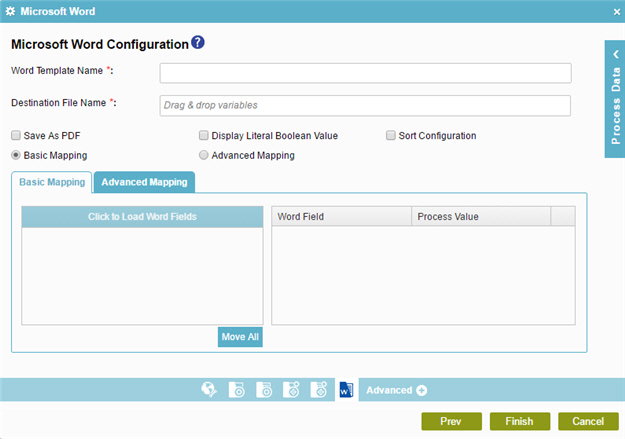Create a Microsoft Word or PDF File
To create a Microsoft Word or PDF file, do the procedure in this topic.

Video: Create a Document in Microsoft Word or PDF Format
Examples
Prerequisites
- An access token for your
source and target
data source to store
the Microsoft Word template file and the output Word or PDF file.
For more information, refer to Access Tokens.
- How Do I Create Repeating Tables in a Document I Can Use with the Microsoft Word Activity?.
- If you use date-time variables in your Microsoft Word template file (.dot or .dotx), they must use syntax \@"[date-time format]".
Example:
\@"M/d/yyyy"
Good to Know
- In most text fields, you can use process data variables as an alternative to literal data values.
- To create a Word template, refer to the online help for Word templates, Mail Merge fields, and bookmark fields in Microsoft Word
- You can configure whether this activity waits for other activities before it runs.
For more information, refer to How Do I Configure an Activity to Wait for Other Incoming Activities?
- Some information about third-party integrations is outside the scope of the AgilePoint NX Product Documentation, and it is the responsibility of the vendors who create and maintain these technologies to provide this information. This includes specific business uses cases and examples; explanations for third-party concepts; details about the data models and input and output data formats for third-party technologies; and various types of IDs, URL patterns, connection string formats, and other technical information that is specific to the third-party technologies. For more information, refer to Where Can I Find Information and Examples for Third-Party Integrations?
How to Start
- On the Application Explorer screen, do one of these:
- Do one of these:
- Add an activity:
- In the Process Builder, in the Activity Library,
open the Document
 tab.
tab. - On the Document
 tab,
drag the Microsoft Word
tab,
drag the Microsoft Word  activity onto your process.
activity onto your process.
- In the Process Builder, in the Activity Library,
open the Document
- Change an activity:
- In your process, double-click your activity.
- Add an activity:
Procedure
- Complete the fields on the
General Configuration screen.
For more information, refer to Configure General Options for a System Activity.
- Click Source Configuration
 .
. - On the Source Repository screen, select the source location of your Microsoft Word template file.
- Click Target Configuration
 .
. - On the Target Repository screen, select the target location for your output Microsoft Word file.
- Click Microsoft Word Configuration
 .
. - On the Microsoft Word Configuration screen, in the Word Template Name field, shows the name of the Word template file that is selected in the source repository.
- In the Destination File Name field, enter the file name of the output file.
You can use Process Data screen to specify a process data variable.
- To connect the process value to the Microsoft Word fields, do one of these:
- Click Basic Mapping.
A warning message shows that you will lose all the mappings in Advanced Mapping.
- To load all the Mail Merge fields, click Click to Load Word Fields.
- Drag and drop the necessary Mail Merge fields to the Word Field list.
To move all the Mail Merge fields to the Word Field list, click Move All.
- In the Process Value column, enter the value to complete in the Word template.
You can use Process Data screen to specify a process data variable.
- Click Advanced Mapping.
A warning message shows that you will lose all the mappings in Basic Mapping.
- Complete this field.
Field Name Definition Map Word Fields
- Function:
- Connects the AgilePoint schema to the Microsoft Word field.
- To Open this Field:
-
- On the Microsoft Word Configuration screen, select Advanced Mapping.
- Accepted Values:
- Click the Schema Mapping
 button to open the
Schema Mapper.
button to open the
Schema Mapper.
Use this screen to connect the response to the data model for your process.
- Default Value:
- None
- Example:
- Refer to:
- Limitations:
-
Some information about third-party integrations is outside the scope of the AgilePoint NX Product Documentation, and it is the responsibility of the vendors who create and maintain these technologies to provide this information. This includes specific business uses cases and examples; explanations for third-party concepts; details about the data models and input and output data formats for third-party technologies; and various types of IDs, URL patterns, connection string formats, and other technical information that is specific to the third-party technologies. For more information, refer to Where Can I Find Information and Examples for Third-Party Integrations?
- Complete this field.
- Click Basic Mapping.
- (Optional) Click Save as PDF to save the file in .pdf format.
- (Optional) Click Advanced
 >
E-mail Notifications
>
E-mail Notifications  .
.
For more information, refer to Configure E-mail Notifications for Any Activity.


